Abstract
The Third Generation Partnership Project (3GPP) has specified Cellular Vehicle-to-Everything (C-V2X) radio access technology in Releases 15–17, with an emphasis on facilitating direct communication between vehicles through the interface, sidelink PC5. This interface provides end-to-end network slicing functionality together with a stable cloud-native core network. The performance of direct vehicle-to-vehicle (V2V) communications has been improved by using the sidelink interface, which allows for a network infrastructure bypass. Sidelink transmissions make use of orthogonal resources that are either centrally allocated (Mode 1, Release 14) or chosen by the vehicles themselves (Mode 2, Release 14). With growing interest in connected and autonomous vehicles, the advancement in radio access technologies that facilitate dependable and low-latency vehicular communications is becoming more significant. This is especially necessary when there are heavy traffic conditions and patterns. We thoroughly examined the New Radio (NR) sidelink’s performance based on 3GPP Releases 15–17 under various vehicle densities, speeds, and distance settings. Thus, by evaluating sidelink’s strengths and drawbacks, we are able to optimize resource allocation to obtain maximum coverage in urban areas. The performance evaluation was conducted on Network Simulator 3 (NS3.34/5G-LENA) utilizing various network metrics such as average packet reception rate, throughput, and latency.
1. Introduction
The aim of connected and autonomous vehicles is to improve traffic flow, reduce fatalities on the road, and reduce the environmental impact of modern mobility, among others [1]. Vehicle-to-Everything (V2X) communication enables the sharing of various types of information (such as traffic, safety and entertainment) with other vehicles, infrastructures and pedestrians using the road through wired and wireless networks. It is essential for ensuring low latency and high dependability [2,3]. V2X communication is made up of three different types of communication: vehicle to vehicle (V2V), vehicle to network or infrastructure (V2N and V2I), and vehicle to pedestrian (V2P) [4].
The 3GPP C-V2X technology, in accordance with the fifth generation (5G) NR, ensures higher efficiency connectivity [5]. Up until now, significant resources have been put into enhancing the efficiency of direct V2V communications using the sidelink interface, which allows for a network infrastructure bypass [6]. In order to facilitate minimum latency V2X communications, 3GPP release version 15 added two additional sidelink transmission modes, Mode 3, and Mode 4 (shown in Figure 1) [7]. In addition to C-V2X Modes 3 and 4, two more sidelink resource allocation NR Modes (1, 2) are now available. In the Release 16 by 3GPP, Mode 1 refers to the network-controlled allocation of Radio Resources (RR)s for sidelink communications. In 3GPP Release 16 Mode 2, individual vehicles can choose their own RRs using a distributed process [8].
Several improvements to the C-V2X standard are included in the NR V2X specifications under the development in Release 16 [9]. These improvements impact both the sidelink PC5 interface that facilitates direct V2V connectivity and the traditional uplink unicast (Uu) cellular interface. NR Mode 1 is also known as a network-controlled mode. In this mode, the base station schedules resources for vehicular UEs to use for sidelink communications. Similar to Mode 3 based on Release 14, Mode 1 only applies to in-coverage conditions. In NR Mode 2 (also known as user equipment autonomous), the network preconfigures a set of sidelink red scenarios, and UEs independently choose how to use them. Similar to Mode 4 in Release 14, Mode 2 can be considered for both in-coverage as well as out-of-coverage cases [10]. This work primarily focuses on Mode 2. Mode 2 follows the sensing-based Semi Persistent Scheduling (SPS) technique described in Release 14. Using this approach, UEs can detect the channel before transmission to select the resources that are less likely to be interfered with and possibly reserve them for a randomized number of consecutive messages.
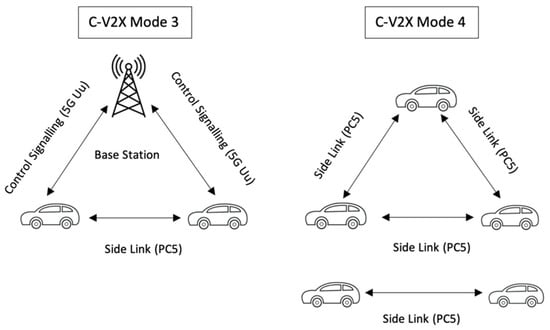
Figure 1.
Cellular V2X (C-V2X) communications transmission modes [11].
2. Background
2.1. Cellular Vehicle to Everything (C-V2X)
C-V2X follows the 3GPP Release 16 specification and ensures better performance than IEEE 802.11p [12]. The widespread cellular infrastructure that already exists can benefit C-V2X users. As it is not always possible to rely on the presence of a cellular infrastructure, transmission modes provided by C-V2X allow direct V2X communications via the sidelink channel using the PC5 interface [11]. C-V2X has a basic time-frequency resource framework, with a sub-frame (1 msec) consisting of 14 OFDM symbols as the smallest time allocation unit and 12 sub-carriers at 15 kHz each (a total of 180 kHz) as the smallest frequency precision. C-V2X devices can transmit utilizing 16-Quadrature Amplitude Modulation (QAM) or Quadrature Phase Shift Keying (QPSK) schemes with the turbo coding in each Orthogonal Frequency-Division Multiplexing (OFDM) subcarrier [7,13].
Additionally, C-V2X users transmit signals for reference as well as control information to data symbols. One of these signals, the Demodulation Reference Signal (DMRS), is utilized for each and every channel estimation. A total of 2 out of 14 OFDM symbols used in Long-Term Evolution (LTE) have DMRS symbols integrated into them, and those four DMRS symbols can be placed in a C-V2X sub-frame because C-V2X is built for high-mobility settings [14]. Both the sidelink interface and the traditional LTE interface can be handled by C-V2X to function with Base Stations (BSs) present in the network or without any BS.
2.2. 5G-V2X
5G-V2X uses Single Carrier Frequency Division Multiple Access (SCFDMA) at the Medium Access Control (MAC) layer and OFDM at the physical layer, whereas 5G-V2X sidelink communications employ Cyclic Prefix Orthogonal Frequency-Division Multiplexing (CPOFDM), which excels in latency as well as high spectral and throughput performance. It is definitely more resistant to frequency Doppler shift and oscillator phase noise as opposed to different multi-carrier waveforms. With the adoption of various modulation formats in 5G-V2X, such as QPSK, 16-QAM, 64-QAM, and 256-QAM using Gray mapping with a binary reflection, high-order modulations can now achieve higher throughput and spectral efficiency at the cost of sidelink coverage [15].
The 5G-V2X Radio Resources (RRs) at the physical layer (PHY) include the frequency and time domain [4]. RRs are organized in frames and subframes with fixed durations of 10 ms and 1 ms, respectively, in the time domain. When the conventional cyclic prefix is used, each subframe is separated into a number of slots, each of which is made up of 14 OFDM symbols. Physical resource block (PRB)s, subchannels, and RRs are arranged in the frequency domain. K consecutive PRBs make up a subchannel, with K being any number of 10, 12, 15, 20, 25, 50, 75, or 100. A total of 12 consecutive subcarriers with subcarrier spacing make up a PRB (SCS). In Figure 2, we illustrate time and frequency domains, the relationship between the Resource Blocks (RB)s, subcarrier, PRB, and subchannel.
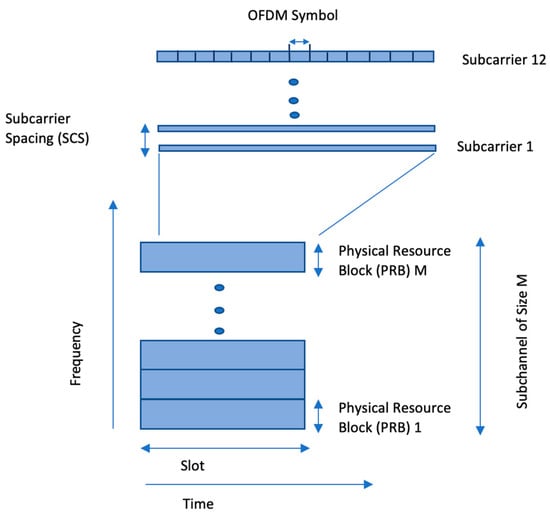
Figure 2.
The time-frequency resource structure for 5G-V2X [16].
2.3. Overview of Sidelink Technology
Sidelink is a cellular technology that offers direct communication between devices whether or not using cellular BS assistance. The 3GPP has been exploring sidelink technology since its Release 12 [17]. Specially dedicated physical layer channels have been designed to support device discovery, synchronization, and sidelink transmission. These channels include the Physical Sidelink Shared Channel (PSSCH), the Physical Sidelink Control Channel (PSCCH), the Physical Sidelink Broadcast Channel (PSBCH), and Sidelink Control Information (SCI) [18]. There is a time-frequency resource structure dividing sidelink channels which consists of contiguous RBs in the frequency domain and 1 ms subframes in the time domain RBs. RBs in the same subframe are collectively referred to as a subchannel (shown in Figure 3) Depending on the setup, there may be a different amount of RBs in the subchannel. The scheduling of time-frequency resources from the RBs consists of recurring sequences of hyper frames which are known as the Scheduling Assignment (SA) or PSCCH period. The SA period is used for direct communication in both sidelink Modes 1 and 2 [18,19]. PSCCHs are controlled by each SA period which is carried by the PSSCH. The SCI carried by the PSCCH contains information on the modulation as well as the coding scheme, the RBs employed, and the resource reserve period. A packet intended for PSSCH transmission is contained in a Transport Block (TB).
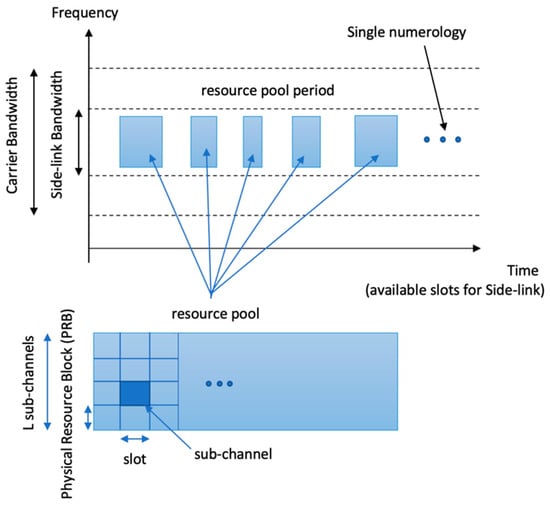
Figure 3.
Resource pool and sidelink bandwidth section for NR V2X sidelink [18].
In Modes 3 and 4, within the same subframe, the TB transmission may occupy adjacent or non-adjacent RBs while the SA is broadcast utilizing specified RBs in the subchannel. Resource conflicts can arise when many devices occasionally choose the same resources from the common pool [19,20]. These choices are therefore coordinated using appropriate collision resolution techniques. Each node may select the resources for the time-frequency to employ in a semi-persistent scheduling mechanism that is currently in use. The competing nodes must employ a sensing-based algorithm to find the least frequent and time-used resources, which the algorithm does not offer [21,22].
Two essential features of sidelink technology, device detection and resource allocation have undergone extensive regulatory requirements and academic research [23,24]. The discovery refers to the capability of using the sidelink (PC5) radio interface to find another device that is nearby. User Equipment (UE)s can accomplish this independently, or it could be done at the network’s core level. It is possible to expand the definition of proximity to take into account elements that UE pairs experience on the radio channel, such as signal quality, throughput, delay and network load [7,25].
2.4. Sidelink in 5G-V2X Mode 2
For 5G-V2X, two sidelink modes, Mode 1 and Mode 2, that represent controlled and autonomous operation methods, are taken into consideration. The autonomous mode is, without a doubt, the more difficult of the two because the interference level and efficiency of the sidelink resource sharing among the vehicles depend heavily on the channel sensing procedures and distributed selection of the resources.
In Mode 2, the UE detects and decodes SCIs transmitted by other UEs over the sidelink channel (associated to each message). The measured values of the Reference Signal Received Power (RSRP) and the decoded SCIs are saved together until a new resource selection needs to be made. These data are utilized to determine which resources must be rejected. Figure 4 shows the Uu-based 5G-D2D communication mode, where vehicles use a BS to communicate over conventional Uplink (UL) and Downlink (DL) channels. Vehicles using PC5-based 5G-D2D (Figure 4 right) communicate with one another through sidelinks, regardless of whether they receive help from BSs that schedule sidelink resources using UL and DL. Resources for transmission are selected at random from the pool of still-accessible resources following the exclusion process [15].
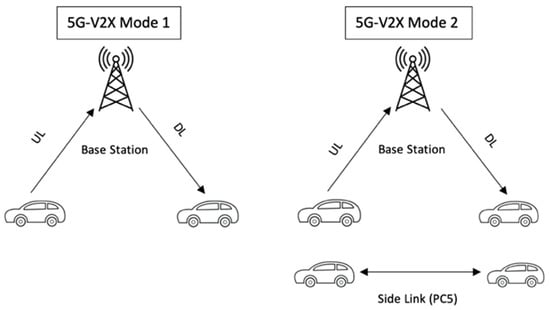
Figure 4.
5G-V2X communication modes: Uplink unicast based 5G-D2D (left) and PC5-based 5G-D2D (right) [25].
Depending on the configuration chosen for each resource pool, the 5G-D2D Mode 2’s sensing window can last either 1100 ms or 100 ms. The UE detects and decodes the SCIs transmitted on the sidelink channel by other UEs during this time. The decoded SCIs and the RSRP measurement are stored together and used to identify which resources need to be overlooked when a new resource selection is required. Resources in 5G-D2D Mode 2 can only be excluded from consideration as potential candidate resources in two situations: either they have already been reserved by a previous SCI with an associated RSRP exceeding a predefined threshold, or the associated information is unavailable (e.g., measurements could not be taken because the station was transmitting). A resource from the pool of remaining accessible resources is chosen at random following the exclusion process [16].
3. Literature Review
For the past few years, studies have been providing a thorough understanding of the 5G-V2X technological characteristics with a focus on its architecture, physical layer, and resource allocation. The performance of CV2X components has been investigated considering a variety of V2X-related scenarios [26,27].
Campolo et al. [8] used the 5G NR V2X communication technology’s direct interactions over the sidelink interface. In order to determine the advantages and disadvantages of the sidelink and autonomous resource allocation schemes under various vehicle density settings, this work examines how well they perform under periodic and aperiodic message generation patterns. In our investigation, we also considered the vehicles’ speed and density to measure the system’s performance.
Using an open-source system-level simulator that implements the 5G NR physical layer aspects together with the specified sidelink resource allocation modes for V2X communications and various data traffic patterns, Todisco et al. [16] carried out a thorough analysis of Mode 2 performance. The outcomes demonstrated how the new 5G-V2X features affected the sidelink resource allocation performance and offered some suggestions for potential future improvements to Mode 2 performance. In contrast to the work presented in [16], we used two traffic scenarios (highway and urban) to present different performances for the same number of vehicles in different traffic patterns.
Mizmizi et al. [28] discussed cooperative position-based systems that use geographic coordinates. They also developed probabilistic approaches of prioritized signals, prompted by the notion that road topological constraints cause a non-uniform distribution of the communication directions. The approach is constructed using historical traffic data and extracting the most important road directions extracted by applying the Hough Transform to a digital map. They also demonstrated how creating a non-uniform quantization, as opposed to a uniform one, reduces performance loss due to the information obtained from the angular probability distribution. In this work, we are using Simulation of Urban Mobility (SUMO) to extract all the traffic information and position of the vehicles.
Petrov et al. [29] examine the performance of Vehicle-to-Infrastructure (V2I) communication in an urban setting using Cellular Vehicle-to-Everything (C-V2X) technologies based on LTE and 5G. The study analyzes variables under different communication settings, such as traffic intensity, communication range, and message frequency, including end-to-end delay and Packet Delivery Ratio (PDR). Furthermore, the effects of different infrastructure densities are investigated using two, four, and eight base stations (BSs). The findings show that both C-V2X technologies efficiently support V2I services, and that performance is greatly improved by increasing the infrastructure density from two to four base stations (BSs). However, in an urban environment, additional increases offer no useful benefits.
While Lien et al. [20] examined direct communications between two UEs despite the need for a base station (BS), 3GPP sidelink transmissions have proven to be essential for Long-Term Evolution Advanced (LTE-A) services, including public safety and V2X communications. In order to evaluate the benefits of the new control channel design, the authors [20] also include a performance evaluation. Potential improvements are also discussed, since NR sidelink transmissions have been seen as a foundation to provide additional features other than V2X in future releases (e.g., advanced relay). In this study, we consider high throughput, high reliability, and low latency V2X services for new sidelink functions that are supported in a NR but not offered in LTE.
Ghodhbane et al. [30] emphasized the standardized technology for cooperative intelligent transport systems and the LTE-V2X mode 4, with particular attention to factors pertaining to traffic load, resource allocation, and Quality of Service (QoS). An analysis in comparison with ITS-G5 was also carried out. The study illustrates how traffic load and sensing-based SPS mechanism parameters significantly affect LTE-V2X performance, and also shows how well LTE-V2X’s QoS mechanism performs in a multi-application scenario when compared to ITS-G5.
Karoui et al. [31] compare the communication mechanisms and performance of two V2X communication technologies, ITS-G5 and C-V2X (LTE-V2X), under a range of use cases. The findings show that ITS-G5 performs well with concurrent LTE data traffic and that LTE-V2X in mode 3 performs poorly because of handovers and eNB scheduling problems.
Petrov et al. [32] focus on two popular technologies for Vehicle-to-Infrastructure (V2I) communication: the more recent LTE-based technologies, such as LTE in the infrastructural mode (LTE-I) and the LTE Device-to-Device mode 3 (LTE-D2D), and the well-known IEEE 802.11p (DSRC). In assessing various technologies, the study takes into account important parameters such as the packet delivery ratio (PDR) and end-to-end delay in the context of urban V2I communication. The findings show that while LTE-I works well in some situations, DSRC is superior at facilitating V2I communication. On the other hand, the LTE-D2D mode 3 has drawbacks, especially when it comes to its inadequate PDR and significant end-to-end latency. The advantages and disadvantages of these technologies as well as their applicability in various V2I communication scenarios are clarified by this comparative analysis.
Maglogiannis et al. [33] highlighted the growing importance of vehicle connectivity and autonomous driving characteristics, which focus on assessing two essential communication standards: C-V2X (3GPP) and ITS-G5 (based on IEEE 802.11p). Using off-the-shelf hardware and a specific vehicle framework called CAMINO, a thorough real-life assessment was carried out under the same traffic conditions to provide an objective comparison. The results show that ITS-G5 has reduced latency in low-density circumstances, while C-V2X PC5 has a greater reach in short-range scenarios. Furthermore, for some use cases, long-range 4G C-V2X shows itself to be a competitive substitute. This experimental investigation provides important information for the advancement of connected and automated driving in the future, including the upcoming 5G technologies.
Decentralized Environmental Messages (DENM)s, which are distributed to vehicles asynchronously, warning them of road hazards and incidents, are one type of aperiodic traffic that Romeo et al. [10] focused on. Simulations were conducted to investigate scenarios in which periodic and event-triggered messages share the same RR pool(s) in the sidelink mode of the autonomous NR V2X. The benefits of that message’s repetitions and their impact on periodically transmitted messages have both been studied by Romeo et al. [10] in various simulation conditions, together with the key factors of the autonomous resource allocation method affecting the delivery of the environmental messages.
Zhao et al. [34] perform a comparative analysis of two vehicle wireless communication technologies: 3GPP Rel-14 LTE-V2X, a recent standard in the cellular industry, and IEEE 802.11p-based dedicated short-range communication (DSRC). An overview of the differences between DSRC and LTE’s physical layer frame structure and channel models is given at the very beginning. Metrics including the packet reception ratio, packet delivery ratio, signal to interference plus noise ratio, and data packet delay during resource selection are examined in highway scenarios through system-level simulation in order to assess performance. The findings show that while LTE provides better reliability at low vehicle densities, DSRC performs better at high densities. Both technologies show comparable communication reliability at short ranges. The research also explores elements such as resource block collisions in LTE, hidden terminals in DSRC, and channel attenuation.
In this work, we focused on the vehicles’ average speed, vehicles’ density, and the number of vehicles to evaluate sidelink’s strength and drawbacks. We used simulation frameworks (NS3 and SUMO) to compare 5G NR Sidelink performances in urban and highway scenarios.
4. Performance Evaluation
4.1. Simulation Settings
In this section, the simulation parameters and conditions are being defined which serve as the basis for the in-depth analysis. This section presents a detailed overview of the simulation environment, including key parameters such as network topology, traffic scenarios, data rate, packet size, sidelink information etc.
4.2. Performance Metrics
- Packet Reception Rate (PRR): PRR is the ratio of all packets received (R) to all packets sent () from the sources.
- Throughput: The rate at which information is sent through the network. The unit is Kbps.
- Latency: The amount of time that passes after a data packet transfer instruction before it starts.
4.3. Simulation Results
When the average speed reduces, there is a decreased likelihood that the resource selection windows of various vehicles will overlap; this is shown in Figure 5a,b generated from simulations based on the parameters in Table 1. The duration of each resource reservation is set in milliseconds (ms) and is fixed for all RBs. As a result, there will be a greater difference in time or slots between the end of the selection window and the start of the subsequent reservation period.
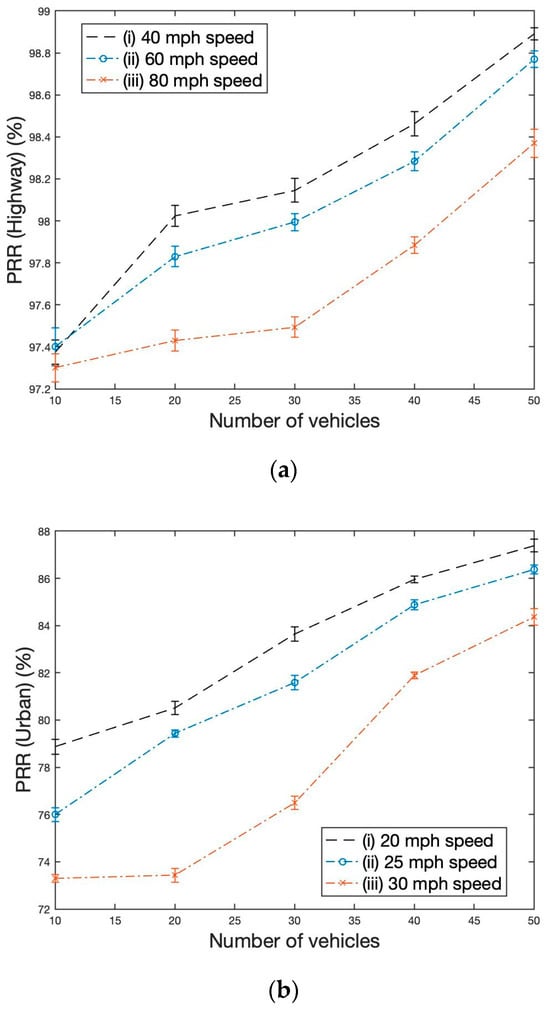
Figure 5.
PRR for different NR-V2X configurations with varying vehicle speeds without retransmissions and varying vehicle numbers. (a) Highway and (b) Urban.

Table 1.
Simulation Parameters.
A reduction in average speed lessens the likelihood that the vehicles’ selection windows will collide. Therefore, it results in a higher PRR when the speed is reduced and similarly shows comparatively poor results in the PRR when the speed of the vehicles is increased. Results shown in Figure 5a,b are significantly similar to the results shown in paper [30].
Figure 6a,b show the results of varying vehicle density without retransmissions. Each packet requires increasingly fewer subchannels as the number of vehicles increases. As more resources become available for selection, there is a chance that the average interference will drop. Thus, in this scenario, as the number of vehicles increases, the packet reception ratio increases. There appears to be a positive correlation between the number of vehicles and the packet reception ratio in C-V2X communication. This correlation can be explained by a cooperative or relaying effect, in which a greater number of vehicles improves network coverage and raises the likelihood of a successful packet reception. However, it is important to note that this trend may not continue indefinitely. This phenomenon typically has a saturation point. The number of bandwidth and time slots that are available for communication may be limited as the number of vehicles increases. The network may eventually become congested, which would result in a decreased packet reception ratio. This saturation effect may be linked to various factors, including resource limitations, interference, and collisions.
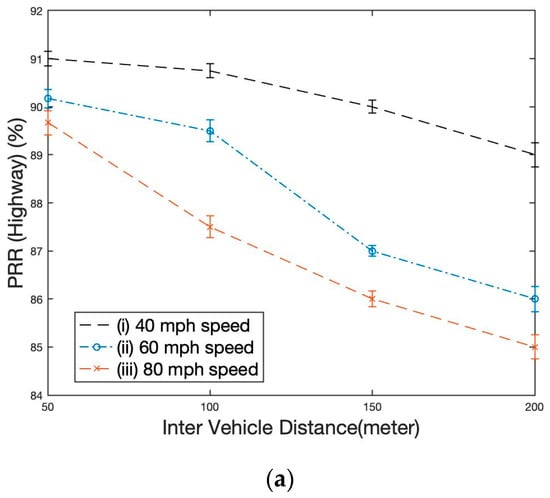
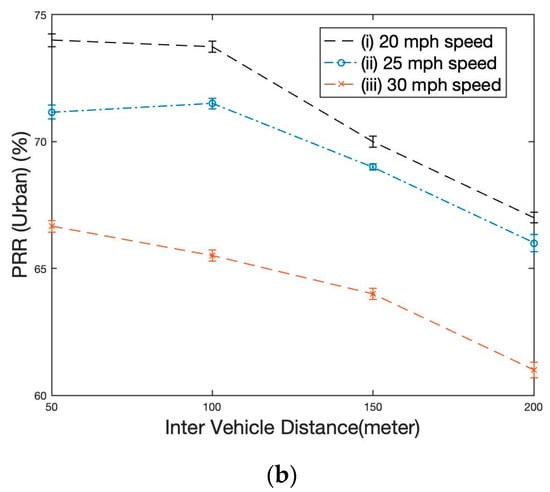
Figure 6.
PRR for different NR-V2X configurations with varying vehicle speeds without retransmissions and varying inter-vehicle distances. (a) Highway and (b) Urban.
Consequently, even though adding additional vehicles might initially improve packet reception, there’s undoubtedly a point at which doing so might not have a major impact on overall performance. The precise limit would be determined by the network infrastructure and the features of the communication environment.
On the other hand, when the speed increases and the vehicle numbers stay the same, the resource update period (which is fixed) is frequently started for new neighbor vehicles. This phenomenon decreases the packet reception ratio which follows a similar phenomenon compared to the results presented in papers [8,16]. In addition to these two studies, this paper shows the comparison of results for varying speed of the vehicles.
Figure 7a,b show the system throughput versus the number of vehicles. It is evident that as there are more vehicles, the throughput increases. This is because more vehicles mean that UEs changed. We compared the system throughput between two different scenarios (highway and urban) as well as when the number of vehicles changing in a certain area. It is observed that for highway scenarios, the system throughput improves by 10%, which is easy to understand because the highway scenario has few obstacles.
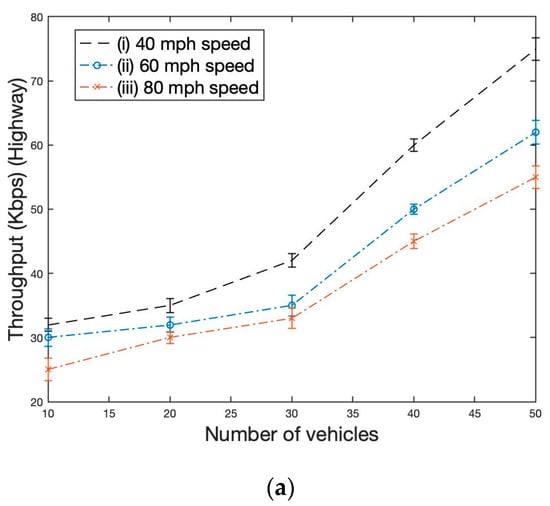

Figure 7.
Throughput for different NR-V2X configurations with varying vehicle speeds without retransmissions and varying vehicle numbers. (a) Highway and (b) Urban.
Figure 8a,b illustrates how the distance between vehicles affects the throughput of the system for two scenarios (highway and urban). It is clear that as the distance between vehicles increases, the system throughput decreases. The system throughput drops by roughly 10 to 20% as vehicles’ distances fall between 50 and 100 m.
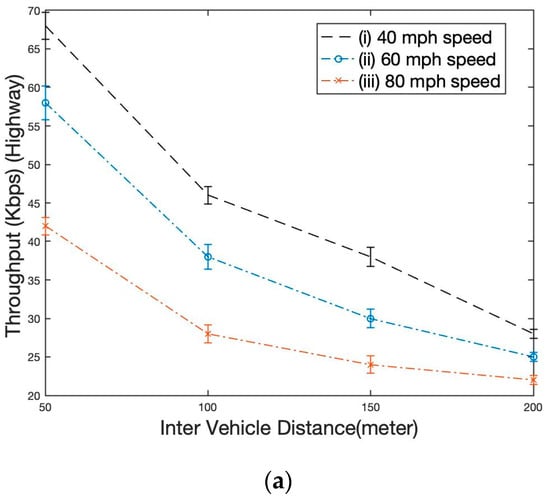

Figure 8.
Throughput for different NR-V2X configurations with varying vehicle speeds without retransmissions and varying inter-vehicle distances. (a) Highway and (b) Urban.
It is evident that the network is greatly impacted by the distance between the vehicles. When vehicles are closer, the sidelink network has an advantage over the network. The speed of the network also affects communication in similar ways as the other cases. It can be observed that lower speeds result in better system performance.
Figure 9a,b illustrates how the distance between vehicles decreases the latency of the system. The result is shown for both highway and urban scenarios. Additionally, it is observed that as average vehicle speed increases, the system latency increases. While transmitting a packet in sidelink, the PSCCH carries SCI messages, which describe the dynamic properties of transmission for the PSSCH. Thus, when the vehicles have increased speed, the PSCCH takes more time to send the SCI message to the PSSCH channel.


Figure 9.
Latency for different NR-V2X configurations with varying vehicle speeds without retransmissions and varying inter-vehicle distances. (a) Highway and (b) Urban.
5. Conclusions
We analyzed 5G-V2X sidelink packet transmission performance for V2X communication considering the differences between highway and urban scenarios. Specifically, we focused on the impact of a varying number of vehicles as well as vehicles’ density and speed. The performance evaluation demonstrates the significant impacts of transmission interference on vehicle speed estimation, communication efficiency, and distance between vehicles. On the other hand, the random allocation of BSs and larger packets can also degrade performance and increase the average interference. These findings will open new directions into resource allocation strategies that consider performance requirements.
Author Contributions
Conceptualization, M.T., F.H.B., A.O. and A.K.; methodology, M.T. and F.H.B.; software, M.T. and F.H.B.; validation, M.T. and F.H.B.; formal analysis, M.T. and F.H.B.; investigation, M.T. and F.H.B.; resources, M.T. and F.H.B.; data curation Tabassum; writing—original draft preparation, M.T., F.H.B., A.O. and A.K.; writing—review and editing, M.T.; visualization, M.T., F.H.B., A.O. and A.K.; supervision, A.O. and A.K.; project administration, M.T., F.H.B., A.O. and A.K.; funding acquisition, A.K. All authors have read and agreed to the published version of the manuscript.
Funding
This work was partially financed by the Project Smart 5G Core And MUltiRAn Integration (SAMURAI) (MCTIC/CGI.br/FAPESP under Grant 2020/05127-2).
Data Availability Statement
We are dedicated to facilitating data sharing for the purpose of transparency, verification, and further research following “MDPI Research Data Policies”. The implementation codes and data of the simulations can be found on the GitHub repository (https://github.com/Mehnaz-Tabassum/NR-Sidelink-Performance-Evaluation-for-Enhanced-5G-V2X-Services), ensuring easy access for further examination.
Conflicts of Interest
I, Mehnaz Tabassum, declare that I have no conflict of interest related to the submitted article, including financial interests, employment or affiliation, personal relationships, funding sources, or intellectual property.
Abbreviations
| Acronyms | |
| 3GPP | Third Generation Partnership Project. |
| BS | Base Station. |
| C-V2X | Cellular Vehicle-to-Everything. |
| CPOFDM | Cyclic Prefix Orthogonal Frequency-Division Multiplexing. |
| DENM | Decentralized Environmental Messages. |
| DL | Downlink. |
| DMRS | Demodulation Reference Signal. |
| LTE | Long-Term Evolution. |
| NR | New Radio. |
| OFDM | Orthogonal Frequency-Division Multiplexing. |
| PRB | Physical Resource Block. |
| PSBCH | Physical Sidelink Broadcast Channel. |
| PSCCH | Physical Sidelink Control Channel. |
| PSSCH | Physical Sidelink Shared Channel. |
| QAM | Quadrature Amplitude Modulation. |
| QPSK | Quadrature Phase Shift Keying |
| RB | Resource Block. |
| RR | Radio Resources. |
| RSRP | Reference Signal Received Power. |
| SCFDMA | Single Carrier Frequency Division Multiple Access. |
| SCI | Sidelink Control Information. |
| SPS | Semi Persistent Scheduling. |
| TB | Transport Block. |
| UE | User Equipment. |
| UL | Uplink. |
| V2V | Vehicle-to-Vehicle. |
| V2X | Vehicle-to-Everything. |
References
- Tabassum, M.; Oliveira, A. Cyber-resilient routing for internet of vehicles networks during black hole attack. Int. J. Wirel. Microw. Technol. 2022, 12, 1–14. [Google Scholar] [CrossRef]
- Campolo, C.; Molinaro, A.; Romeo, F.; Bazzi, A.; Berthet, A.O. 5G NR V2X: On the impact of a flexible numerology on the autonomous sidelink mode. In Proceedings of the 2019 IEEE 2nd 5G World Forum (5GWF), Dresden, Germany, 30 September–2 October 2019; pp. 102–107. [Google Scholar]
- Dixit, A.; Chidambaram, R.K.; Allam, Z. Safety and risk analysis of autonomous vehicles using computer vision and neural networks. Vehicles 2021, 3, 595–617. [Google Scholar] [CrossRef]
- Adelantado, F.; Ammouriova, M.; Herrera, E.; Juan, A.A.; Shinde, S.S.; Tarchi, D. Internet of Vehicles and Real-Time Optimization Algorithms: Concepts for Vehicle Networking in Smart Cities. Vehicles 2022, 4, 1223–1245. [Google Scholar] [CrossRef]
- Kim, J.; Noh, G.; Kim, T.; Chung, H.; Kim, I. Link-level performance evaluation of mmwave 5G NR sidelink communications. In Proceedings of the 2021 International Conference on Information and Communication Technology Convergence (ICTC), Jeju Island, Republic of Korea, 20–22 October 2021; pp. 1482–1485. [Google Scholar]
- Bazzi, A.; Berthet, A.O.; Campolo, C.; Masini, B.M.; Molinaro, A.; Zanella, A. On the design of sidelink for cellular V2X: A literature review and outlook for future. IEEE Access 2021, 9, 97953–97980. [Google Scholar] [CrossRef]
- Molina-Masegosa, R.; Gozalvez, J. LTE-V for sidelink 5G V2X vehicular communications: A new 5G technology for short-range vehicle-to-everything communications. IEEE Veh. Technol. Mag. 2017, 12, 30–39. [Google Scholar] [CrossRef]
- Campolo, C.; Todisco, V.; Molinaro, A.; Berthet, A.; Bartoletti, S.; Bazzi, A. Improving resource allocation for beyond 5G V2X sidelink connectivity. In Proceedings of the 2021 55th Asilomar Conference on Signals, Systems, and Computers, Pacific Grove, CA, USA, 31 October–3 November 2021; pp. 55–60. [Google Scholar]
- 3GPP TR 38.885 V16.0.0; Study on NR Vehicle-to-Everything (V2X); Alliance for Telecommunications Industry Solutions: Washington, DC, USA, 2019.
- Romeo, F.; Campolo, C.; Molinaro, A.; Berthet, A.O. Denm repetitions to enhance reliability of the autonomous mode in NR V2X sidelink. In Proceedings of the 2020 IEEE 91st Vehicular Technology Conference (VTC2020-Spring), Antwerp, Belgium, 25–28 May 2020; pp. 1–5. [Google Scholar]
- Naik, G.; Choudhury, B.; Park, J.-M. IEEE 802.11 bd & 5G NR V2X: Evolution of radio access technologies for V2X communications. IEEE Access 2019, 7, 70169–70184. [Google Scholar]
- Papathanassiou, A.; Khoryaev, A. Cellular V2X as the essential enabler of superior global connected transportation services. IEEE 5G Tech Focus 2017, 1, 1–2. [Google Scholar]
- Shrestha, R.; Nam, S.Y.; Bajracharya, R.; Kim, S. Evolution of V2X communication and integration of blockchain for security enhancements. Electronics 2020, 9, 1338. [Google Scholar] [CrossRef]
- Filippi, A.; Moerman, K.; Martinez, V.; Turley, A.; Haran, O.; Toledano, R. IEEE 802. 11p ahead of LTE-V2V for safety applications. Autotalks NXP 2017, 1, 1–19. [Google Scholar]
- Bartoletti, S.; Decarli, N.; Masini, B.M. Sidelink 5G-V2X for integrated sensing and communication: The impact of resource allocation. In Proceedings of the 2022 IEEE International Conference on Communications Workshops (ICC Workshops), Seoul, Republic of Korea, 16–20 May 2022; pp. 79–84. [Google Scholar]
- Todisco, V.; Bartoletti, S.; Campolo, C.; Molinaro, A.; Berthet, A.O.; Bazzi, A. Performance analysis of sidelink 5G-V2X mode 2 through an open-source simulator. IEEE Access 2021, 9, 145648–145661. [Google Scholar] [CrossRef]
- Mishra, D.; Trotta, A.; Traversi, E.; Di Felice, M.; Natalizio, E. Cooperative cellular UAV-to-everything (C-U2X) communication based on 5G sidelink for UAV swarms. Comput. Commun. 2022, 192, 173–184. [Google Scholar] [CrossRef]
- Alrabady, A.I.; Mahmud, S.M. Analysis of attacks against the security of keyless-entry systems for vehicles and suggestions for improved designs. IEEE Trans. Veh. Technol. 2005, 54, 41–50. [Google Scholar] [CrossRef]
- Garcia, M.H.C.; Molina-Galan, A.; Boban, M.; Gozalvez, J.; Coll-Perales, B.; Şahin, T.; Kousaridas, A. A tutorial on 5G NR V2X communications. IEEE Commun. Surv. Tutor. 2021, 23, 1972–2026. [Google Scholar] [CrossRef]
- Lien, S.-Y.; Deng, D.-J.; Lin, C.-C.; Tsai, H.-L.; Chen, T.; Guo, C.; Cheng, S.-M. 3GPP NR sidelink transmissions toward 5G V2X. IEEE Access 2020, 8, 35368–35382. [Google Scholar] [CrossRef]
- Ganesan, K.; Lohr, J.; Mallick, P.B.; Kunz, A.; Kuchibhotla, R. NR sidelink design overview for advanced V2X service. IEEE Internet Things Mag. 2020, 3, 26–30. [Google Scholar] [CrossRef]
- Ghosh, A.; Maeder, A.; Baker, M.; Chandramouli, D. 5G evolution: A view on 5G cellular technology beyond 3GPP release 15. IEEE Access 2019, 7, 127639–127651. [Google Scholar] [CrossRef]
- Bazzi, A. Congestion control mechanisms in IEEE 802.11 p and sidelink C-V2X. In Proceedings of the 2019 53rd Asilomar Conference on Signals, Systems, and Computers, Pacific Grove, CA, USA, 3–6 November 2019; pp. 1125–1130. [Google Scholar]
- Bonjorn, N.; Foukalas, F.; Pop, P. Enhanced 5G V2X services using sidelink device-to-device communications. In Proceedings of the 2018 17th Annual Mediterranean ad Hoc Networking Workshop (Med-Hoc-Net), Capri Island, Italy, 20–22 June 2018; pp. 1–7. [Google Scholar]
- Hasan, M.; Mohan, S.; Shimizu, T.; Lu, H. Securing vehicle-to-everything (V2X) communication platforms. IEEE Trans. Intell. Veh. 2020, 5, 693–713. [Google Scholar] [CrossRef]
- Liu, Z.; Liu, Q.; Shea, R.; Cai, W.; Wang, Z.; Ran, Y. Intelligent resource management for 5G. Wirel. Netw. 2020, 26, 1535–1536. [Google Scholar] [CrossRef]
- Honarvar, R.; Zolghadrasli, A.; Monemi, M. Context-oriented performance evaluation of network selection algorithms in 5G heterogeneous networks. J. Netw. Comput. Appl. 2022, 202, 103358. [Google Scholar] [CrossRef]
- Mizmizi, M.; Linsalata, F.; Brambilla, M.; Morandi, F.; Dong, K.; Magarini, M.; Nicoli, M.; Khormuji, M.N.; Wang, P.; Pitaval, R.A.; et al. Fastening the initial access in 5G NR sidelink for 6G V2X networks. Veh. Commun. 2022, 33, 100402. [Google Scholar] [CrossRef]
- Petrov, T.; Pocta, P.; Kovacikova, T. Benchmarking 4G and 5G-Based Cellular-V2X for Vehicle-to-Infrastructure Communication and Urban Scenarios in Cooperative Intelligent Transportation Systems. Appl. Sci. 2022, 12, 9677. [Google Scholar] [CrossRef]
- Ghodhbane, C.; Kassab, M.; Maaloul, S.; Aniss, H.; Berbineau, M. A Study of LTE-V2X Mode 4 Performances in a Multiapplication Context. IEEE Access 2022, 10, 63579–63591. [Google Scholar] [CrossRef]
- Karoui, M.; Freitas, A.; Chalhoub, G. Performance comparison between LTE-V2X and ITS-G5 under realistic urban scenarios. In Proceedings of the 2020 IEEE 91st Vehicular Technology Conference (VTC2020-Spring), Antwerp, Belgium, 25–28 May 2020; IEEE: New York, NY, USA, 2020; pp. 1–7. [Google Scholar]
- Petrov, T.; Sevcik, L.; Pocta, P.; Dado, M. A performance benchmark for dedicated short-range communications and lte-based cellular-v2x in the context of vehicle-to-infrastructure communication and urban scenarios. Sensors 2021, 21, 5095. [Google Scholar] [CrossRef] [PubMed]
- Maglogiannis, V.; Naudts, D.; Hadiwardoyo, S.; Akker, D.V.D.; Marquez-Barja, J.; Moerman, I. Experimental V2X evaluation for C-V2X and ITS-G5 technologies in a real-life highway environment. IEEE Trans. Netw. Serv. Manag. 2021, 19, 1521–1538. [Google Scholar] [CrossRef]
- Zhao, J.; Gai, X.; Luo, X. Performance Comparison of Vehicle Networking Based on DSRC and LTE Technology. In Proceedings of the International Conference on Intelligent Transportation Engineering, Beijing, China, 17–19 September 2021; Springer Nature Singapore: Singapore, 2021; pp. 730–746. [Google Scholar]
Disclaimer/Publisher’s Note: The statements, opinions and data contained in all publications are solely those of the individual author(s) and contributor(s) and not of MDPI and/or the editor(s). MDPI and/or the editor(s) disclaim responsibility for any injury to people or property resulting from any ideas, methods, instructions or products referred to in the content. |
© 2023 by the authors. Licensee MDPI, Basel, Switzerland. This article is an open access article distributed under the terms and conditions of the Creative Commons Attribution (CC BY) license (https://creativecommons.org/licenses/by/4.0/).